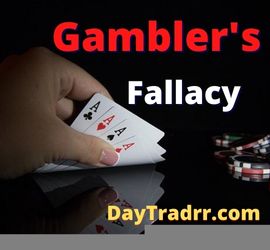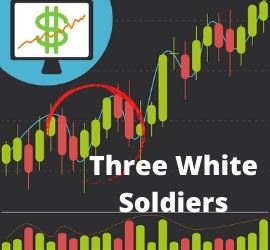What Is the Gambler’s Fallacy?
 The gambler’s fallacy arises when a person incorrectly believes that the outcome of a previous event or series of events makes a specific random occurrence less probable or more likely to occur. This line of thought is wrong since past experiences have no bearing on the likelihood that specific events will occur in the future. In other words, the gambler’s fallacy refers to the mistaken belief that the likelihood of a random occurrence occurring in the future is influenced by previous instances of that sort of event.
The gambler’s fallacy arises when a person incorrectly believes that the outcome of a previous event or series of events makes a specific random occurrence less probable or more likely to occur. This line of thought is wrong since past experiences have no bearing on the likelihood that specific events will occur in the future. In other words, the gambler’s fallacy refers to the mistaken belief that the likelihood of a random occurrence occurring in the future is influenced by previous instances of that sort of event.
For example, the gambler’s fallacy can lead someone to believe that if a coin they tossed landed on heads two or more times in a row, it will most likely land on tails the next time. It is important for investors to be aware of the gambler’s fallacy since it influences how people think. It doesn’t just happen at the roulette table or when gambling. The gambler’s fallacy can come into play when it comes to other areas of life – including investing and trading.
Gambler’s Fallacy – A Closer Look
Consider a succession of occurrences that is random and independent of one another. By definition, the outcome of one or more events cannot impact or anticipate the outcome of the following event. The gambler’s fallacy involves incorrectly determining whether a series of occurrences is truly random and independent. Then, incorrectly concluding that the following event will have the opposite outcome as the previous series of events.
Imagine a series of ten coin flips that all land with the tails side up. Someone might predict that the next coin flip has a higher probability to land with the heads side up. However, the coin has a 50/50 probability of landing on either side. Further, the coin flips are not consistently tied to one another by some mechanism. Therefore, it is the gambler’s fallacy to expect that the next coin flip has more or less than a 50/50 chance. This is regardless of how many heads or tails were previously tossed in a row. The probability of a fair coin landing on heads is always 50%. Because each coin flip is an autonomous event, previous flips have no influence on future flips.
Pitfalls when Trading and Investing
It can affect any of us when we are assessing the probability of a future event by looking at past events that are similar. We do this all the time in both our personal and professional lives. Consider an investor who sees a stock’s continuous rise in value as an indication that it will shortly crash. On that basis alone, he decides to sell. Similarly, if a stock has lost value, this can be interpreted as a sign that it is about to turn around and appreciate. Again, on that basis alone, he decides to keep the losing stock.
The gambler’s fallacy may be at work here. This is because investors sometimes make decisions based on the likelihood of a fairly random event. In this case, an investor makes decisions on a stock price that is based on the history of comparable historical events. Not to be overlooked, is the trend in its previous price direction that might indicate a potential turnaround. The two are not always related. A stock that has been rising in value may continue to rise, or it may fall. And, its past price trajectory does not predict its future price trajectory.
Example – Gambler’s fallacy Investing and Trading
The gambler’s fallacy is an incorrect understanding of probability that can also be applied to investment. Some investors sell a position after it has increased in value over a period of several trading sessions. They do so because they mistakenly assume that the position is now far more likely to see a reversal. This belief is solely based on the result of the prior string of consecutive gains.
Consider an investor who purchases two stocks for his portfolio. One stock quickly drops by -30 percent while the other rises by +30%. The investor will often sell the +30% gainer to lock in his good luck and a tidy profit. However, studies show he may decide to keep the -30% loser, thinking it will rebound and recover. His decision to keep the loser is motivated not by a rational strategy or analysis. Rather, his motivation is the desire to avoid emotional distress by experiencing a large loss on his stock decision. So, rather than selling the position and reallocating his capital to another stock, he stays on until the loss goes away. Or at least becomes modest enough that he may sell without feeling horrible. This form of bias is motivated by emotion rather than strategy.
Gambler’s Fallacy – Holding Losers and Selling Winners
The gambler’s fallacy has been found to have an impact on the financial analysis process. Investors tend to hold equities that have declined and sell stocks that have increased. According to economists Hersh Shefrin and Meir Statman, this is referred to as a general inclination to sell winners too soon and hold losers too long.
For example, it has been argued that the disposition effect in finance (the tendency of investors to sell stocks that have appreciated and hold stocks that have lost value) is caused by gambler’s fallacy beliefs. In particular, the reasoning goes, that if a stock has risen repeatedly in the past, it’s due for a downturn and thus it’s time to sell. Similarly, stocks that have lost value are due to appreciation, so one should hold those stocks (Shefrin and Statman, 1985; Odean, 1998). Other evidence demonstrates that consumers’ mutual fund purchases depend strongly on the past performance of particular fund managers (Sirri and Tufano, 1998), even though the data suggest that the performance of mutual fund managers is serially uncorrelated. Thus, individuals are presumably making investment decisions based upon the belief that particular funds or fund managers are“hot.” (Source: stat.berkeley.edu)
Real-life Example of the Gambler’s Fallacy
The most famous instance of a gambler’s fallacy occurred in 1913 at the Monte Carlo Casino. The roulette wheel’s ball had repeatedly landed on black. This caused people to believe that the ball would soon fall on red. As a result, they began pushing their chips, betting that the ball would land in a red square on the following roulette wheel turn. After 27 spins, the ball finally landed on the red square. According to accounts, millions had been lost by that point. The erroneous belief was that the streak was generating an imbalance in the randomness of the wheel. Therefore, it had to be followed by a long streak of red, which proved to be incorrect. Consider that the roulette wheel was properly functioning and unbiased. The probability of a sequence of either red or black occurring 26 times in a row is around 1 in 66.6 million.
Summary
The gambler’s fallacy is the false idea that if a random event occurred more frequently than expected in the past, it is less likely to occur in the future (and vice versa). Randomness refers to situations where these events are independent of one another. For example, the gambler’s fallacy can lead someone to believe that if a coin they tossed landed on heads twice in a row, it is more likely to land on tails the next time. The gambler’s fallacy is primarily caused by the expectation that even brief sequences of results will be highly indicative of the mechanism that generated them. Also, the perception that chance occurrences are fair and exhibit a self-correcting process.
How to avoid gambler’s fallacy when investing and trading
It is rather unexpected, but inexperienced investors are not the only ones to succumb to the gambler’s fallacy and the disposition effect. Even expert investors such as fund managers are susceptible. So, if you want to avoid the unnecessary drag on your investment performance, you need to keep your emotions in check. Be disciplined in selling underperforming investments while riding successes – as long as they continue performing. The amount an investment has gained or lost in the past is mostly irrelevant. Do your research and choose only the best value for your investment dollars. Don’t invest in trends alone – choose value first when making buy, hold, and sell decisions.
Up Next: Tesla Competitors – Tesla’s 12 Biggest Competitors Worldwide
 Tesla Inc. is the current leader in designing, manufacturing, and selling electric automobiles. But there are Tesla competitors gaining rapidly on the leader as the EV market grows and matures. Tesla Inc. (TSLA) is an American designer, developer, and distributor of electric vehicles and powertrains. Serial entrepreneur Elon Musk heads the company which was established in 2003 and is based in Palo Alto, California. It is estimated there are 1.2 to 1.3 billion cars on the road worldwide, including approximately 60 million electric vehicles. As a result, EVs have a limited market share, although it is still early. Tesla is unquestionably the industry leader in the design, manufacture, and selling of electric automobiles.
Tesla Inc. is the current leader in designing, manufacturing, and selling electric automobiles. But there are Tesla competitors gaining rapidly on the leader as the EV market grows and matures. Tesla Inc. (TSLA) is an American designer, developer, and distributor of electric vehicles and powertrains. Serial entrepreneur Elon Musk heads the company which was established in 2003 and is based in Palo Alto, California. It is estimated there are 1.2 to 1.3 billion cars on the road worldwide, including approximately 60 million electric vehicles. As a result, EVs have a limited market share, although it is still early. Tesla is unquestionably the industry leader in the design, manufacture, and selling of electric automobiles.
Tesla sold its first electric vehicle, the Roadster, in 2008. Initially, the cost of purchasing an EV was prohibitively expensive for the general population. However, as technology has advanced, lower-cost models have been created. Also, the barrier to entry for new entrants has been significantly reduced. However, there are Tesla competitors are lining up outside and within the United States. Numerous companies are rapidly positioning themselves to compete with, and possibly even surpass, Elon Musk at his own game. Below are Tesla’s biggest competitors from across the globe.




